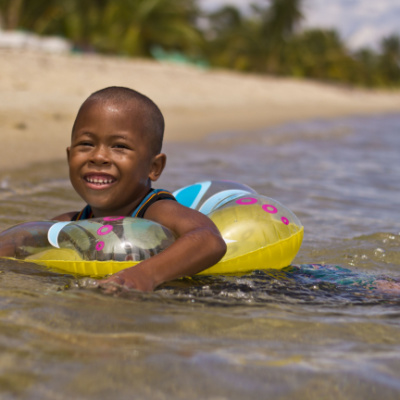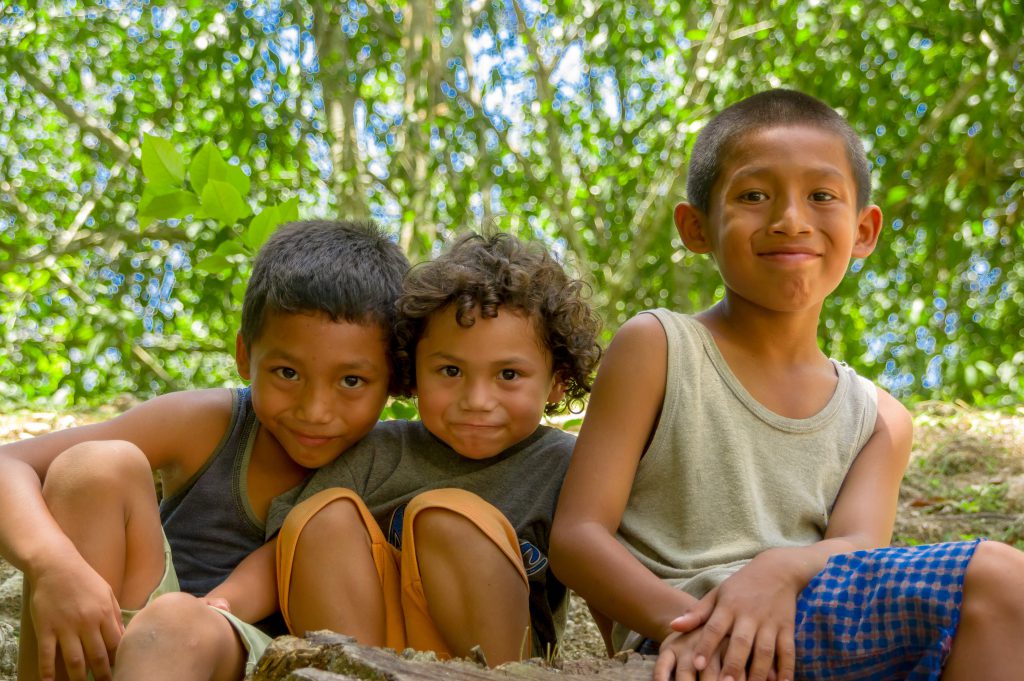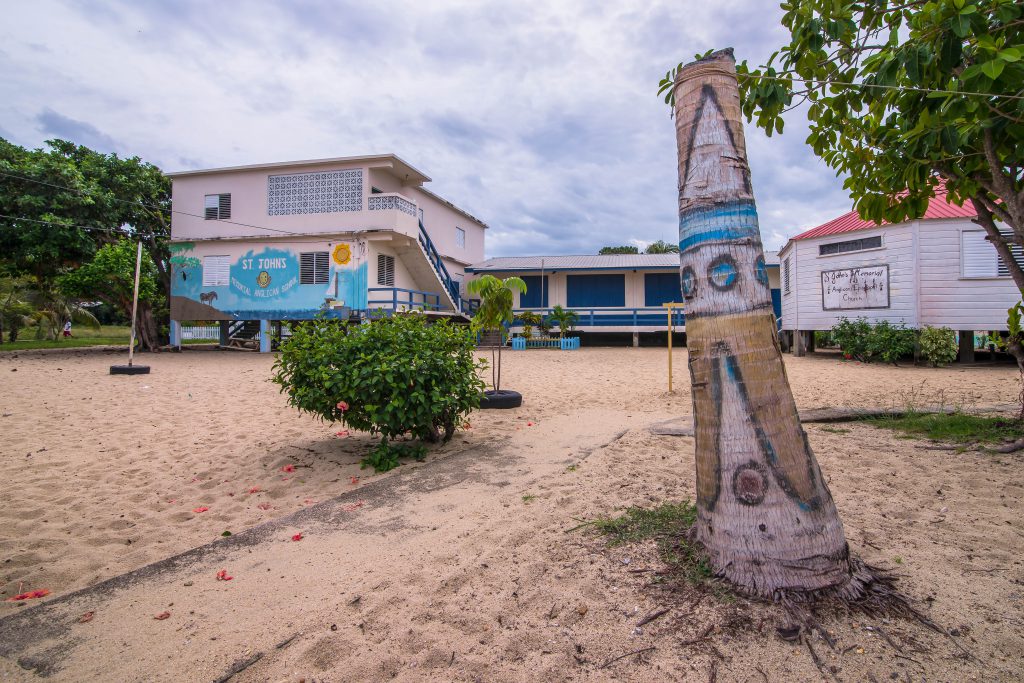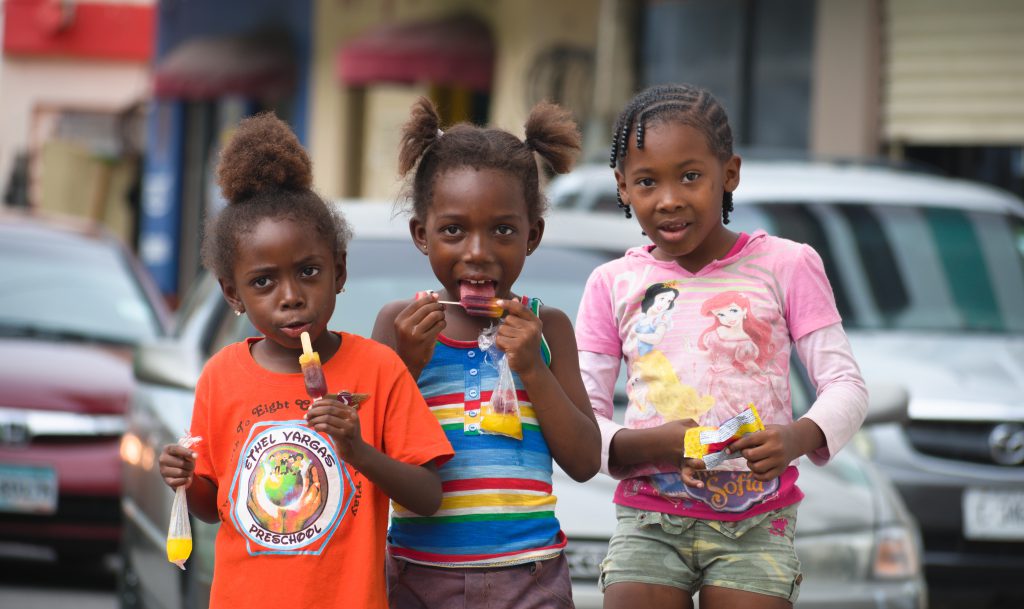Realising children’s rights in Belize


Belize ratified the United Nations Convention on the Rights of the Child 1989 in May 1990, and Optional Protocols covering a wide range of human rights issues, including the Sale of Children, and Children in Armed Conflict protocols, in December 2003. Unfortunately, however, Belize still faces serious problems around secondary education, child marriage, and child involvement in organised crime.

Children’s Rights Index: 8,16 / 10
Yellow level: Satisfactory situation
Population: 412,000
Pop. ages 0-14: 29%
Life expectancy: 75 years
Under-5 mortality rate: 1.2‰
Belize at a glance
Belize is in the Northeast of the Caribbean region and borders Mexico, Guatemala, and the Caribbean Sea. Despite being a relatively small country, it has the lowest population density of any country in Central America, with a population of 412,000, though also has a high rate of growth, as reflected by the number of children in the general population: 39.4% aged 0-18, 29% 0-14, and 10.5% under the age of 5 (MICS5, 2016; World Bank, 2020).
Belize has a rich and complex history. In 1500 BC, the Mayan civilisation began to settle in the region, where they remained for the next 1,000 years. The culture of Belize has also been shaped by centuries of exploration and colonial occupation, dating back to the voyage of Christopher Columbus in the 15th Century. The Spanish also tried to settle in the region, but struggled due to a lack of resources and native hostility, though the country became a flashpoint for tensions between Spain and the UK.
In 1840, Belize became a British colony, known as British Honduras, before gaining independence in 1981. As a result of these various cultural influences, over half the population is multilingual. English is the official language, but a large proportion also speaks Belizean Creole and Spanish, and there are traces of Mayan and other European languages.
Belize has strong cultural and economic ties with Latin American and Caribbean countries while being a member of the Commonwealth. King Charles III is the Head of State, represented by the Governor General, Froyla Tzalam, who was appointed in 2021. Belize is a democratic state, with widespread voting rights introduced in 1954 when women became part of the franchise.
Belize struggled during the Covid-19 pandemic. Tourism is the dominant industry, and travel restrictions, therefore, presented serious challenges for the economy, with 50% of households becoming unemployed, 60% suffering a reduction in income, and severe consequences for children, such as increased domestic abuse (UNICEF, n.d.; UNICEF, 2020).
Status of children’s rights [1]
Belize ratified the UNCRC 1989 in May 1990, and Optional Protocols covering a wide range of human rights issues, including the Sale of Children, and Children in Armed Conflict protocols, in December 2003. It has also signed the ILO Minimum Age Convention (1973) and the ILO Worst Forms of Child Labour Convention (1999).

Belize has also supported the implementation of the 2030 Agenda for Sustainable Development, adopted by world leaders in 2015. In particular, Belize has taken leadership on key issues for the Central American and Caribbean region, such as energy, environment and migration. Belize has also set its own targets ahead of the 2030 deadline, such as the five-year plan to end child marriage, which is a top priority for children’s rights in the country (UNICEF, n.d.).
Addressing the needs of children
Right to education
The right to basic education is recognised by the preamble to the Belize Constitution of 1981, supplemented by compulsory education for children aged 6-14, with parents subject to fines if children regularly fail to attend school. Furthermore, education is free for all students under the age of 14. As a result, primary school enrolment has been extremely high from 1990-2020, with one estimate that 94.5% of children between 5 and 14 attend full-time (Bureau of International Labor Affairs, 2020).
The same cannot be said of secondary education. There is no equivalent measure requiring students to enrol in secondary school, and, as a result, net enrolment drops to 68% for 2020, which represents only a minor increase from 61% in 1990 and 65% in 2011 (UNESCO, 2020).

The rising costs of education provide one reason for this drop; secondary education is not free, and 60% of students benefit from a small subsidy of $150 per year for expenses such as uniforms and books. It is also possible that students are deterred because education is delivered in English, which could discourage students from Spanish communities (Bureau of International Labor Affairs, 2020). On the flip side, although participation in secondary education is low, there are also concerns about the quality of education, particularly due to the lack of qualified teachers, basic resources and condition of facilities (Bureau of International Labor Affairs, 2020).
Right to health
The right to basic health is also enshrined in the preamble to the Constitution, and provided by public and private sector systems. Recent evidence shows significant progress in the promotion of children’s health. For example, the infant mortality rate is 1%, and 94% of births are attended by skilled medical staff. The mortality rate for children aged between 0-5 years is 1.2‰, down from 3.8‰ in 1990, and 2.4‰ in 2000.
There has also been progress in life expectancy, from 69 in 2000 to 75 in 2020, which indicates similar progress for healthcare at all ages. As a result, Belize has received high ratings for its promotion of the right to health: 83% in general, and 99.1% for children (HRMI, 2018).
However, there are specific risk factors for children’s health arising from acute poverty in the country. Most obvious is the risk of malnutrition, which is of particular concern for the 15% of children under five who suffer from stunted growth, although this fell from 22% in 2006 (Global Nutrition Report, 2019).
Belize has struggled with one of the highest rates of HIV/AIDS in the Caribbean region, though there are gaps in the data for children. It is estimated that 1.9% of the adult population between 15 and 49 currently suffer from the disease. The evidence also offers an indirect glimpse of the effect that this relatively high adult prevalence has had on children, with 2,300 children aged between 0 and 17 orphaned due to AIDS (UNAIDS, 2020).
Right to water and sanitation
There are significant concerns about the implementation of the right to WASH (Water, Sanitation and Hygiene) in Belize, partly due to gaps in the available evidence. The country has made progress on improved water and sanitation facilities, with 97% of the population enjoying improved water resources in 2009, and 81% for sanitation facilities (Grau, 2013).
However, there is some concerning evidence as to the provision of safe water and sanitation in schools. For example, research conducted by UNICEF shows that more than 20% of schools report an unreliable water supply, and 25% have an untreated supply. The statistics for sanitation in schools are even worse, with only 30% meeting the international standard of one toilet per 25 girls, and one per 50 boys (UNICEF, n.d.).
Sewerage presents another major problem, with only 11% of the population having access to sewerage infrastructure and treatment, and 21% of the urban population, which, while low, is typical of the Caribbean region (Grau, 2013). In order to overcome these problems, the Belize government faces significant logistical challenges, particularly because the population is spread across low-density communities, which are not easily connected by piping.
Risk factors→ Country-specific challenges
Child abuse

Domestic abuse is a significant problem for children’s rights in Belize, despite being expressly prohibited in the Families and Children Act 2003. UNICEF has found that 42% of babies aged between 1 and 2 have been physically abused, rising to 59% for toddlers between 3 and 6. This rate of harm increases even further, with 65% of children aged 0-14 reporting physical and psychological abuse from parents and caregivers (UNICEF, n.d.; UNICEF, 2020).
Child marriage
Child marriage is one of the priority issues for children’s rights in Belize. 20% of girls and 10% of boys aged between 15 and 19 are married, and 29% of women currently between 20 and 29 were married or cohabiting before the age of 18 (UNICEF, n.d.). This is the second highest level of child marriage and early unions in the Caribbean region, and evidence shows that children forced into early marriages are more likely to be out of education as well as suffer domestic violence and sexual disease.
Belize has acknowledged this problem and taken steps to reduce harm through broad policy intervention. In 2020, Belize launched a five-year plan to end child marriage, ahead of the 2030 target set out in the UN Sustainable Development Goals. This plan is the first of its kind in the Caribbean region and focuses on changing social attitudes, providing health advice and strengthening enforcement laws (UNICEF, n.d.).
Violence
Gangs present significant challenges for children across Mexico and the Caribbean region. Unfortunately, Belize, and, in particular, Belize City, the largest city, struggles with high rates of child involvement. According to one report, 20% of children in Belize City report either current or prior involvement with gangs, while an additional 10% are at high risk of involvement due to close contact with gang members through family, friends and the local community (Young, 2019).
Such a high rate of involvement has consequences across the spectrum of children’s rights. For example, it leads to the situation where 100% of the sample group report losing at least one friend or relative to gang violence, with adverse consequences for mental health (Young, 2019).
There are also drastic consequences for the right to education. The average age of induction is 14.5, with the majority reporting some form of involvement between the ages of 13 and 16, and some also reporting trouble with the Police from as early as 12 (Young, 2019; UNICEF, n.d.). Among children involved in gang violence, there is a very high rate of school suspension, and exclusion, with 76% reporting having dropped out, the most common year of dropout being Standard 6, the final year of primary education (Young, 2019).
The Belize Government has sought to address the problem through policy interventions in the form of summer camps led by the Conscience Youth Development Programme (CYDP), though the ongoing status of this organisation is in doubt due to cutbacks in public funding (UNICEF, n.d.).
Child labour
The problem of gangs is closely linked to the issue of child labour, particularly in extreme forms, such as child prostitution and trafficking. While there is a significant shortage of research on this issue, we understand that 1.6% of children aged 5-14 are in full-time work, with a further 1.2% combining work with education (Bureau of International Labor Affairs, 2020).
For those children who are in work, we understand that 64.9% are employed in services, such as hospitality, retail, cooking and textiles, 24.6% in agriculture, and 10.5% in construction, though these statistics fail to account for the who are children employed by gangs to sell drugs, firearms, and even carry out a violent crime, such as murder (Bureau of International Labor Affairs, 2020).
Belize does not meet international standards on child labour; in particular, the Labour Act 2000 (Article 169(a)) sets the legal threshold for child labour at 12 years old, which points to the wider problem of no consistent legal definition of the child for the purpose of policy making. The Belize Government has acknowledged these problems with the launch of policy initiatives, such as the National Plan of Action for Children and Adolescents 2004-15, and also the National Child Labour Policy, though the rate and extent of intervention have been criticised (Bureau of International Labor Affairs, 2020).
Environmental challenges
Belize is vulnerable to the effects of extreme weather and climate change so 4% of GDP is spent on recovery each year, which could be invested in public health and education. For example, Tropical Storm Eta, a deadly Category 4 hurricane, hit Central America in November 2020.

It is estimated that 1.2 million children were affected across the Caribbean region, including 440,000 evacuated to shelter, which also acted as a vector for Covid-19 transmission. The impact on Belize was relatively low compared with other countries, such as Honduras: despite having a population 20 times the size of Belize, 40 times as many children were affected. In Belize, only 21,000 children were thought to have been affected, with 45 displaced to shelters (UNICEF, n.d.).
In the long term, the adverse effects of extreme tropical weather will be exacerbated by the accelerating effects of climate breakdown, particularly as Belize is naturally vulnerable because of low-lying terrain. This threatens to disrupt the entire range of children’s rights, including the right to life (Art 6), health (Art 24), standard of living (Art 27), and education (Art 28).
Written by Patrick Naylor
Last updated on 7 December 2022
References:
Child Morality, (2020) ‘Child Morality Estimates: Belize’ [statistics] Retrieved from: https://childmortality.org/data/Belize accessed on 20 March 2022
Bureau of International Labor Affairs, (2020) ‘2020 findings on the worst forms of child labour’ Retrieved from: https://www.dol.gov/sites/dolgov/files/ILAB/child_labor_reports/tda2020/Belize.pdf accessed on 28 March 2022
Global Nutrition Report, (2019) ‘Country Nutrition Profile: Belize’ [statistics] Retrieved from: https://globalnutritionreport.org/resources/nutrition-profiles/latin-america-and-caribbean/central-america/belize/ accessed on 20 March 2022
Grau, J., del Rosario, M., Rihm, A., Ducci, J., Martin, D., Kuratomi, T., (2013) ‘Water and Sanitation in Belize’ Retrieved from https://publications.iadb.org/publications/english/document/Water-and-Sanitation-in-Belize.pdf accessed on 28 March 2022
HRMI Rights Tracker, (2018) ‘Belize’ [statistics] Retrieved from: https://rightstracker.org/en/country/BLZ accessed on 20 March 2022
MICS, (2016) ‘Multiple Indicator Cluster Survey 2015-6: Belize’ [statistics] Retrieved from: https://mics-surveys-prod.s3.amazonaws.com/MICS5/Latin%20America%20and%20Caribbean/Belize/2015-2016/Final/Belize%202015-16%20MICS_English.pdf accessed on 28 March 2022
Ngozi Ezeilo, J., (2013) ‘Report of the Special Rapporteur on trafficking in persons, especially women and children’ Retrieved from: https://documents-dds-ny.un.org/doc/UNDOC/GEN/G14/148/92/PDF/G1414892.pdf?OpenElement accessed on 28 March 2022
The World Bank, (2020) ‘Population ages 0-14 (% of total population): Belize’ Retrieved from: https://data.worldbank.org/indicator/SP.POP.0014.TO.ZS?locations=BZ accessed on 28 March 2022
UNAIDS, (2020) ‘Belize’ [statistics] Retrieved from: https://www.unaids.org/en/regionscountries/countries/belize accessed on 20 March 2022
UNESCO Institute for Statistics, (2020) ‘Belize’ [statistics] Retrieved from: http://uis.unesco.org/en/country/bz accessed on 20 March 2022
UNICEF, (n.d.) ‘Belize: Care for Child Development’ [article] Retrieved from: https://www.unicef.org/belize/care-child-development accessed on 20 March 2022
UNICEF, (n.d.) ‘Belize: Water, sanitation and hygiene’ [article] Retrieved from: https://www.unicef.org/belize/water-sanitation-and-hygiene-wash accessed on 20 March 2022
UNICEF, (2020) ‘Changing perceptions of Covid-19 risk in Belize’ [statistics] Retrieved from: https://mics.unicef.org/news_entries/165/CHANGING-PERCEPTIONS-OF-COVID-19-RISK-IN-BELIZE accessed on 20 March 2022
UNICEF, (n.d.) ‘Belize launched road map to end child marriage and early unions’ [article] Retrieved from: https://www.unicef.org/belize/press-releases/belize-launches-road-map-end-child-marriage-and-early-unions accessed on 20 March 2022
UNICEF, (n.d.) ‘Central America Tropical Storm Eta Humanitarian Situation Report’ [report] Retrieved from: https://www.unicef.org/documents/lacro-humanitarian-situation-report-hurricanes-eta-and-iota-february-2021 accessed on 20 March 2022
UNICEF, (n.d.) ‘At-risk youth camp facilities prevention of gang integration’ [article] Retrieved from: https://www.unicef.org/belize/stories/risk-youth-camp-facilities-prevention-gang-integration accessed on 28 March 2022
Young, M., Inter-American Development Bank (2019), ‘Belize City Community Gang Involvement’ Retrieved from: https://publications.iadb.org/publications/english/document/Belize_City_Community_Gang_Assessment_en.pdf accessed on 28 March 2022
[1] This article by no means purports to give a full or representative account of children’s rights in Belize; indeed, one of the many challenges is the scant updated information on children in Belize, much of which is unreliable, not representative, outdated or simply non-existent.

